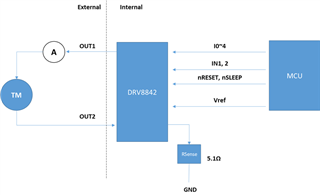Other Parts Discussed in Thread: DRV8842-EP, DRV8842,
Hello,
This is a question regarding current regulation of DRV8842-EP.
We are now testing the current regulation function of DRV8842 on the evaluation board.
The test evaluation is below;
Target : DRV8842EVM
Rsense : 5.1ohm
Vref : 2.5v
Moter(TM) : L=43mH, R=24.9ohm
VM : 24v
We would like to check current regulation with adjustable Ichop.
IN1 and IN2 is constant. IN1 is 14%, IN2 is 0%.
In this case, Ichop is adjusted between 0% to 100%, and expected current value is 100mA.
Results of each test case is as a following;


In these results, Act current and expected current is disagree when Ichop is lower than 80%.
We would like to operate current regulation when Ichop is between 0% to 100%.
Could you please tell me about configuration of correctly operated current regulation?
Thanks,
Sho



